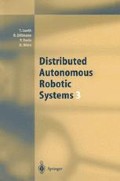Abstract
Mobile robots may utilize interrobot sensing and communications to improve the cooperative navigation capabilities of a group based on optimal estimation and control algorithms [12]. In this paper, we show that cooperative teaming strategies based on these principles may be used to further improve navigation. The partition of the group into virtual teams is used to optimally balance the net speed of motion with the uncertainty in navigational position. Analysis of the CNS principles for partitioned groups leads to simulation experiments in which alternative teaming strategies are evaluated based on an overall time-uncertainty cost function. The results suggest that smaller teams of robots are preferred when interrobot sensing is more accurate, since the use of other teams as position references is more effective. Similarly, a round-robin motion plan among teams yields the best compromise between speed and uncertainty. The resulting analysis and strategies are directly applicable to cooperative robot applications in which some robot subgroups adopt navigation service tasks to assist in overall navigation of the group.
Access this chapter
Tax calculation will be finalised at checkout
Purchases are for personal use only
Preview
Unable to display preview. Download preview PDF.
References
R. Chatila and J. Iaumond, “Position referencing and consistent world modeling for mobile robots,” Proc. 1.985 IEEE Int. Conf. Robotics and Automation, pp. 138–145, 1985.
J. L. Crowley, “Navigation for an intelligent mobile robot,” IEEE J. Robotics and Automation RA-1(1), 31–41, 1985.
IL Durrant-Whyte, “Consistent, integration and propagation of disparate sensor observations,” Int. J. of Robotics Research, Spring, 1987.
IL F. Durrant-Whyte. “Sensor models and multisensor integration,” Int. J. Robotics Research, 7 (C), 97–113, 1988.
T. Fukuda and S. Nakagawa, “Approach to the dynamically reconfigurable robot systems,” J. Intel. Robotic Systems, 1, 55–72, 1988.
R. Kurazume, S. Hi rose, S. Nagata, and N. Sashida, “A study on cooperative positioning system (basic principle and measurement experiment),” Proc. 1996 IEEE Int.. Con, on Robotics and Automation, Minneapolis, MN, pp. 1421–1426, 1996.
J. J. Leonard and IL F. Durrant-Whyte, “Mobile robot localization by tracking geometric beacons,” IEEE Trans, on Robotics and Automation, Vol. 7, No. 3, pp. 376–382, 1991.
II. Joshi and A. C. Sanderson, “Multisensor fusion and model selection using a minimal representation criterions,” Proc. 1996 IEEE Conference on Multisensor Fusion, December, 1996.
F. L. Lewis, Optimal Estimation, John Wiley, New York, 1986.
R. C. Luo and C. K. Kay, “Multisensor integration and fusion in intelligent systems,” IEEE Trans. Syst. Man. Cybern, 19 (5), 901–931, 1989.
S. Maeyama, A. Ohya, and S. Yuta, “Non-stop outdoor navigation of a mobile robot,” Proc. 1995 Conference on Intelligent Robots and Systems, pp. 130–135, 1995.
A. C. Sanderson, “Cooperative navigation among multiple mobile robots,” Distributed Autonomous Robotics Systems 2, eds. H. Asamaet al.. Springer-Verlag, Tokyo, 1996.
R. Smitli and P. Cheeseman, “On the estimation and representation of spatial uncertainty,” Int. J. Robotics Research, 5(4), Winter, 1987.
K. Sugihara and S Suzuki, “Distributed algorithms for formation of geometric patterns with many mobile robots,” Jnl. of Robotic Systems, 13 (3), 127–139, 1996.
T. Tsubouchi and M. Rude, “Motin planning for mobile robots in a time-varying environment: A survey,” Journal of Robotics and Mechatronics, Vol. 8, No. 1, 1996.
Y. Watanabe and S. Yuta, “Estimation of position and its uncertainty in the dead reckoning system of the wheeled mobile robot,” Proc. 20th 1SIR, pp. 205–212, 1990.
D.-Y. Yeung and G. A. Bekey, “A decentralised approach to the motion planning problem for multiple mobile robots,” Proc. 1987 IEEE Int. Conf. Robotics and Automation, Raleigh, NC, pp 1779–1784, 1987.
Author information
Authors and Affiliations
Rights and permissions
Copyright information
© 1998 Springer-Verlag Berlin Heidelberg
About this paper
Cite this paper
Sanderson, A.C. (1998). Multirobot Navigation Using Cooperative Teams. In: Distributed Autonomous Robotic Systems 3. Springer, Berlin, Heidelberg. https://doi.org/10.1007/978-3-642-72198-4_16
Download citation
DOI: https://doi.org/10.1007/978-3-642-72198-4_16
Publisher Name: Springer, Berlin, Heidelberg
Print ISBN: 978-3-642-72200-4
Online ISBN: 978-3-642-72198-4
eBook Packages: Springer Book Archive

